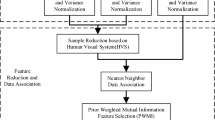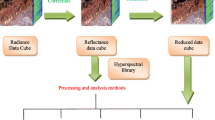Abstract
An infrared search and track system is an important research goal for military applications. Although there has been much research into small infrared target detection methods, we cannot apply them in real field situations due to the high false alarm rate caused by clutter. This paper presents a novel target attribute extraction and machine learning-based target discrimination method. In our study, eight target features were extracted and analyzed statistically. Learning-based classifiers, such as SVM and Adaboost, have been incorporated and then compared to conventional classifiers using real infrared images. In addition, the generalization capability has also been inspected for various types of infrared clutter.



















Similar content being viewed by others
References
Arnold J, Pasternack H (1990) Detection and tracking of low-observable targets through dynamic programming. Proc SPIE 1305:207–217
Bai Z, Zhou F, Jin T, Xie Y (2007) Infrared small target detection and tracking under the conditions of dim target intensity and clutter background. Proc SPIE 6786
Belkin M, Niyogi P, Sindhwani V (2006) Manifold regularization: a geometric framework for learning from labeled and unlabeled examples. J Mach Learn Res 7:2399–2434
Blum AL, Langley P (1997) Selection of relevant features and examples in machine learning. Artif Intell Eng Des Anal Manuf 97:245–271
Caefer CE, Mooney JM, Silverman J (1995) Point target detection in consecutive frame staring IR imagery with evolving cloud clutter. Proc SPIE 2561:14–24
Campana SB (1993) The infrared and electro-optical systems handbook. SPIE Opt Eng Press 5(4)
Chan DSK (1992) A unified framework for ir target detection and tracking. Proc SPIE 1698:66–76
Chan DSK, Langan DA, Staver DA (1990) Spatial processing techniques for the detection of small targets in IR clutter. Proc SPIE 1305:53–62
Crosby F (2005) Signature adaptive target detection and threshold selection for constant false alarm rate. J Electron Imag 14(3)
Csurka G, Dance CR, Fan L, Willamowski J, Bray C (2004) Visual categorization with bags of keypoints. Workshop on statistical learning in computer vision, ECCV, pp 1–22
de Jong AN (1995) IRST and perspective. Proc SPIE 2552:206–213
Bouma H, de Lange D-JJ, van den Broek SP, Kemp RAW, Schwering PBW (2008) Automatic detection of small surface targets with electro-optical sensors in a harbor environment. Proc SPIE 7114
Despande SD, Er MH, Venkateswarlu R, Chan P (1999) Max-mean and max-median filters for detection of small-targets. Proc SPIE 3809:74–83
Dijk J, van Eekeren AWM, Schutte K, de Lange D-JJ (2007) Point target detection using super-resolution reconstruction. Proc SPIE 6566:65660U
Duda RO, Hart PE, Stork DG (2001) Pattern classification, 2nd edn. Wiley-Inersicence, New York
Zelinsky A, Loy G (2003) Fast radial symmetry for detecting points of interest. IEEE Trans Pattern Anal Mach Intell 25(8):959–973
Gregoris DJ, Yu SKW, Tritchew S (1994) Detection of dim targets in flir imagery using multiscale transforms. Proc SPIE 2269:62–71
Hsu C-W, Chang C-C, Lin C-J (2010) A practical guide to support vector classification
Hubbard WA, Page GA, Carroll BD, Manson DC (1999) Feature measurement augmentation for a dynamic programming based IR target detection algorithm in the naval environment. Proc SPIE 2698:2–9
Joachims T. SVMlight available at http://www.cs.cornell.edu/People/tj/svmlight
Khan JF, Alam MS (2005) Target detection in cluttered forward-looking infrared imagery. Opt Eng 44(7)
Kim S (2010) Double layered-background removal filter for detecting small infrared targets in heterogeneous backgrounds. J Infrared Millimeter Terahertz Waves 32(1):79–101
Kim S, Choi B, Kim J, Kwon S, Kim K-T (2012) Three plot correlation-based small infrared target detection in dense sun-glint environment for infrared search and track. Proc SPIE 8393:83930T
Kim S, Yang Y, Choi B (2010) Realistic infrared sequence generation by physics-based infrared target modeling for infrared search and track. Opt Eng 49:116401
Kohavi R, John GH (1997) Wrappers for features subset selection. Int J Digit Libr 1:108–121
Kumar S (2004) Detection and tracking algorithms for IRST, M. Tech Cedit Seminar Report, IIT Bombay
Longmire MS, Takken EH (2003) LMS and matched digital filters for optical clutter suppression. Appl Opt 27(6):1141–1159
Luo J-H, Ji H-B, Liu J (2007) An algorithm based on spatial filter for infrared small target detection and its application to an all directional IRST system. Proc SPIE 6279
Luo Y, Tao D, Geng B, Xu C, Maybank SJ (2013) Manifold regularized multitask learning for semi-supervised multilabel image classification. IEEE Trans Image Process 22(2):523–536
Maji S, Berg AC, Malik J (2008) Classification using intersection kernel support vector machines is efficient. IEEE conference on computer vision and pattern recognition, 2008. CVPR 2008, pp 1–8
Melacci S, Belkin M (2011) Laplacian support vector machines trained in the primal. J Mach Learn Res 12:1149–1184
Mikolajczyk K, Schmid C (2001) Indexing based on scale invariant interest points. In: Proceedings of the 8th international conference on computer vision, Vancouver, pp 525–531
New WL, Tand MJ, Er MH, Venkateswarlu R (1999) New method for detection of dim point-targets in infrared images. Proc SPIE 3809:141–150
Novak LM (1994) Radar target identification using an eigen-image approach. IEEE national radar conference, pp 129–131
Ondini A, Marsiglia G, Fortunato L, Balzarotti G (2006) Techniques for detection of multiple, extended, and low contrast targets in infrared maritime scenarios. Opt Eng 45(12)
Pajares G, Ruz JJ, de la Cruz JM (2009) Image change detection from difference image through deterministic simulated annealing. Pattern Anal Appl 12(2):137–150
Reed IS, Gagliardi RM, Stotts LB (1990) A recursive moving-target-indication algorithm for optical image sequences. IEEE Trans Aerospace Electron Syst 26(3):434–440
Rivest J-F, Fortin R (1996) Detection of dim targets in digital infrared imagery by morphological image processing. Opt Eng 35(7):1886–1893
Ronda V, Er MH, Deshpande SD, Chan P (1999) Multi-mode algorithm for detection and tracking of point-targets. Proc SPIE 3692:269–278
Rozovskii B, Petrov A (1999) Optimal nonlinear filtering for track-before-detect in ir image sequences. Proc SPIE 3809:152–163
Sang H, Shen X, Chen C (2003) Architecture of a configurable 2-d adaptive filter used for small object detection and digital image processing. Opt Eng 48(8):2182–2189
Sang N, Zhang T, Shi W (1998) Detection of sea surface small targets in infrared images based on multi-level filters. Proc SPIE 3373:123–129
Serrano AJ, Soria E, Martin JD, Magdalena R, Gomez J (2010) Feature selection using roc curves on classification problems. The 2010 international joint conference on neural networks (IJCNN), pp 1–6
Shirvaikar MV, Trivedi MM (1995) A neural network filter to detect small targets in high clutter backgrounds. IEEE Trans Neural Netw 6(1):252–257
Silverman J, Mooney JM, Caefer CE (1997) Tracking point targets in cloud clutterr. Proc SPIE 3061:496–507
Soni T, Zeidler JR, Ku WH (1993) Performance evaluation of 2-d adaptive prediction filters for detection of small objects in image data. IEEE Trans Image Process 2(3):327–340
Thiam E, Shue L, Venkateswarlu R (2002) Adaptive mean and variance filter for detection of dim point-like targets. Proc SPIE 4728:492–502
Torralba A, Murphy KP, Freeman WT (2007) Sharing visual features for multiclass and multiview object detection. IEEE Trans Pattern Anal Mach Intell 29:854–869
Tzannes AP, Brooks DH (2000) Point target detection in ir image sequences: a hypothesis-testing approach based on target and clutter temporal profile modeling. Opt Eng 39(8):2270–2278
van den Broek SP, Bakker EJ, de Lange D-J, Theil A (2000) Detection and classification of infrared decoys and small targets in a sea background. Proc SPIE 4029:70–80
Wallraven C, Caputo B, Graf A (2003) Recognition with local features: the kernel recipe. In: Proceedings of the ninth IEEE international conference on computer vision, vol 2, ICCV ’03, pp 257–264
Wang G, Zhang T, Wei L, Sang N (1996) Efficient method for multiscale small target detection from a natural scene. Opt Eng 35(3):761–768
Wang G-D, Chen Ch-Y, Shen X-B (2005) Facet-based infrared small target detection method. Electron Lett 41(22):1244–1246
Wang YL, Dai JM, Sun XG, Wang Q (2006) An efficient method of small targets detection in low SNR. J Phys Conf Ser 48:427–430
Warren RC (2002) Detection of distant airborne targets in cluttered backgrounds in infrared image sequences, Ph.D. Thesis, University of South Australia
Wu B, Ji H-B (2008) Improved power-law-detector-based moving small dim target detection in infrared images. Opt Eng 47(1):010503
Yu J, Liu D, Tao D, Seah HS (2011) Complex object correspondence construction in two-dimensional animation. IEEE Trans Image Process 20(11):3257–3269
Yu J, Liu D, Tao D, Seah HS (2012) On combining multiple features for cartoon character retrieval and clip synthesis. IEEE Trans Syst Man Cybern Part B 42(5):1413–1427
Yu J, Tao D, Wang M (2012) Adaptive hypergraph learning and its application in image classification. IEEE Trans Image Process 21(7):3262–3272
Yu J, Wang M, Tao D (2012) Semisupervised multiview distance metric learning for cartoon synthesis. IEEE Trans Image Process 21(11):4636–4648
Zhang B, Zhang T, Cao Z, Zhang K (2007) Fast new small-target detection algorithm based on a modified partial differential equation in infrared clutter. Opt Eng 46(10)
Zhang L, Du B, Zhong Y (2010) Hybrid detectors based on selective endmembers. IEEE Trans Geosci Remote Sens 48(6):2633–2646
Zhang L, Zhang L, Tao D, Huang X (2011) A multifeature tensor for remote-sensing target recognition. IEEE Geosci Remote Sens Lett 8(2):374–378
Acknowledgments
This work was supported by the Basic Science Research Program through the National Research Foundation of Korea (NRF) funded by the Ministry of Education, Science and Technology (No. 2011-0009684) and by the Sensor Target Recognition Laboratory (STRL) program of Defense Acquisition Program Administration and Agency for Defense Development.
Author information
Authors and Affiliations
Corresponding author
Electronic supplementary material
Below is the link to the electronic supplementary material.
Electronic supplementary material
Rights and permissions
About this article
Cite this article
Kim, S. Analysis of small infrared target features and learning-based false detection removal for infrared search and track. Pattern Anal Applic 17, 883–900 (2014). https://doi.org/10.1007/s10044-013-0361-7
Received:
Accepted:
Published:
Issue Date:
DOI: https://doi.org/10.1007/s10044-013-0361-7




